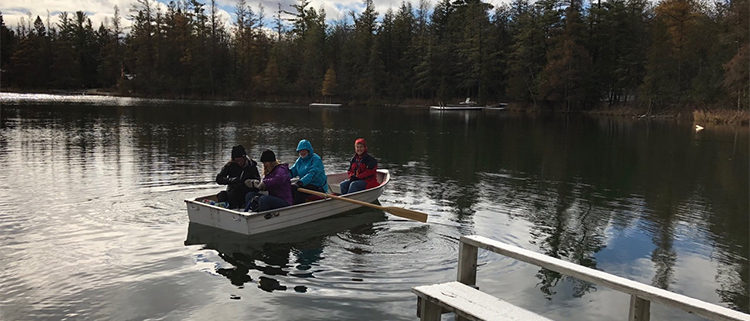Lake Monitoring and Research
We were extremely lucky in 2017 to be able to engage experts and students from numerous organizations, ministries, and universities to monitor, research and study in-depth our lake and surrounding watershed to better understand the toxic cyanobacteria outbreak we experienced at the end of the summer and well into the autumn of 2016. While our budget was extremely modest (about $9,000 counting all the funds the Lake Association was able to pool) we were able to leverage tens of thousands of dollars of research grants, volunteer time, laboratory time/materials, and other resources.
Each individual water sample can cost hundreds of dollars to analyze and we were able to have labs at the University of Waterloo, University of Western Ontario, The Dorset Fresh Water Ecology Centre, and the Ministry of Environment and Climate Change Toronto Labs run hundreds of samples for us – testing and learning about the water in our creeks, lake surface, and lake depths week after week throughout the year.
While it is only one year of data we have learned a lot including:
– all of our creeks at one point or another (some consistently) exceed the acceptable levels for nutrients including phosphorus and nitrogen,
– most of our creeks have high levels of e-coli and coliform – even the seemingly “pristine” creeks coming straight from the forests,
– we have some very concerning nutrient levels coming into the lake from lawns and septic tanks,
– the lake bottom has exceptionally high phosphorus levels – likely accumulated over decades that is ready to fuel the next cyanobacteria outbreak at any time,
– the lake has a very unusual blob of Plantothrix (a potentially toxic) cyanobacteria that hovers in a huge cloud spanning the entire lake at about 7m depth but can rise up, drop down, and move in unison as required for optimal conditions or avoid attack by predators such as water based fungi or UV rays,
– the outlet water coming out of Sunfish Lake (the start of Laurel Creek) frequently exceeds acceptable levels of nutrients and e-coli – passing our issues further downstream too.
There was no single source of our problems found instead confirmation that we have many issues that we need to address including:
– doing whatever is possible to improve the water quality in our streams and tributaries,
– launching a war on phosphorus including soaps, shampoos, fertilizers, and other common nutrient sources,
– dealing better with pet waste and human waste – including upgrades to all of our septic systems,
– ensuring that geese, ducks, and seagulls do not contribute additional nutrients to the lake,
– finding ways to extract the surplus phosphorus from the lake,
– doing everything we can to prevent future cyanobacteria and algae outbreaks that can release toxins into the lake that can kill fish, animals, and humans.
The Water Team has developed a budget for the coming year to try to do as much as we can with our modest resources and keeping things realistic for area property owners – trying to balance what we need to be doing and the tremendous expense with what might be possible to do at a more reasonable budget and still have a considerable impact. This includes a levy of $450 in addition to the usual $300 annual fee to be used towards:
– the tremendous costs of monitoring (monthly, semi-monthly and weekly depending on the time of year) using professional hydrologists so we can be confident that the lake water is safe,
– research /measurement/ data collection working with university, masters and Ph’d students to better understand our ecosystem so that we can develop effective solutions,
– learning more about the Planktothrix blob that blankets the middle regions of the lake – including how long it has been here, whether it is positive (contributing oxygen to our fish) or negative (creating toxins), etc.
– learning more about possible solutions.
Once again we are so lucky to have organizations willing to partner with us and devote considerable resources to helping us out – saving us tens of thousands of dollars on testing, laboratory costs, research, professional consulting fees, etc..
Many thanks to our Water Team that has spent hundreds of hours over the past year out in every possible extreme weather condition gathering measurements and samples, reading, researching, meeting, and trying to work on the leading edge of science (even artificial intelligence) to find the needed solutions. Because of the unique meromictic aspects of our lake, the manageable size of our watershed and the unusual findings of the researchers we were able to assemble one of the largest, most comprehensive teams of cyanobacteria researchers in the world with several of the global leaders helping to advise on our situation.
While they continue to be confounded by our Planktotrhix blob, they are optimistic that we will be able to work diligently over the years ahead to get our nutrient situation under control and have a healthy, thriving lake ecosystem in the future – even in the face of global climate change. It will take a lot of work and effort however, it is far superior to the alternative trajectory that we are currently on of increasing nutrient levels leading to increasing algae outbreaks, increasing e-coli and coliform contamination, declining water quality, increasing threats of toxicity, and eventually the lake becoming an unsafe cesspool as so many other lakes and water systems globally are experiencing.




